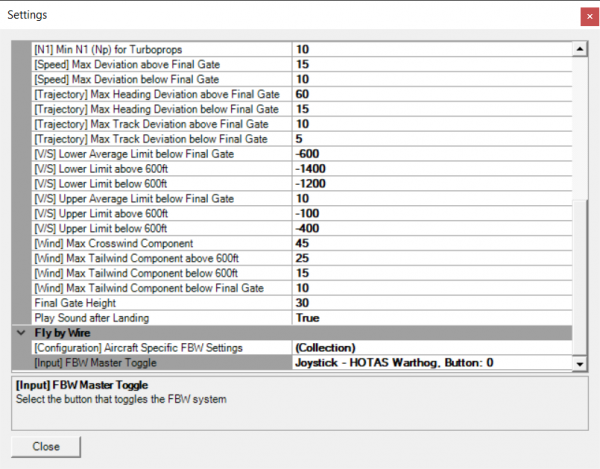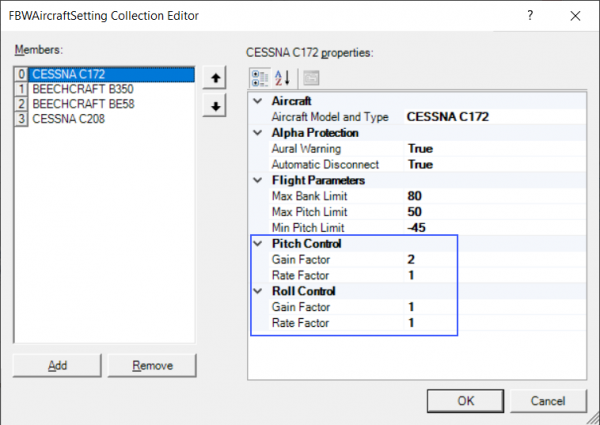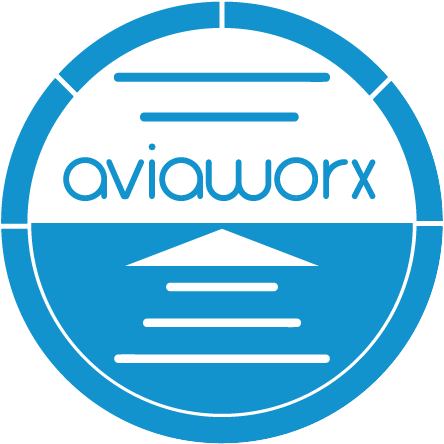A new sensation of flight
aviaFlyByWire redefines your manual flight experience without compromising realism.
What is it?
aviaFlyByWire is a flight control augmentation system that takes care of making manual flight easy, intuitive and smooth.
How does it work?
aviaFlyByWire intercepts your flight control hardware’s aileron and elevator signals (let’s call them X and Y values) and redirects these signals to a flight control loop. This then interprets the raw signals and uses them to command roll and pitch rates (the more you deflect your elevator, the faster the pitch change). Finally, the control loop calculates the actual aileron and elevator surface positions and sends these output signals to the aircraft. Very similar to the fly-by-wire mechanisms found in complex airliners.
Does it work with every aircraft?
Yes! (*)
(*): As long as your aircraft’s developer isn’t using ‘exotic’ / non-standard methods of manipulating control surfaces or implementing their own control loops (e.g. if your aircraft already comes with a fly-by-wire system, adding aviaFlyByWire to the mix may result in unwanted conditions).
Preview
Can I test it before buying?
Yes! aviaFlyByWire has a demo mode where it will work without limitations around Salzburg, Austria. Once you leave Salzburg, aviaFlyByWire will disengage.
Pricing
See the aviaServer page for pricing details.
How is aviaFlyByWire used?
aviaFlyByWire, like every other aviaWorx app, is fully integrated into aviaServer – so make sure that is running.
First off, you need to assign a button on your hardware to activate / deactivate aviaFlyByWire. This can be easily done through the Settings dialog of aviaServer:

Hint: Scroll down to the end of the button list and choose ‘Detect…’ to easily select a button on any connected device!
Depending on your current flight regime, the following will happen when you active aviaFlyByWire:
- On the ground: aviaFlyByWire will arm itself but will not modify your control input. This is called Direct Mode
- During takeoff: aviaFlyByWire’s so-called Normal Mode, where roll and pitch rate are actively commanded, is blended-in progressively. So at lift-off, you will be Direct Mode and gradually aviaFlyByWire will take over control, resulting in a smooth transition
- In the air: aviaFlyByWire’s Normal Mode is active. Should pre-set envelope limits be exceeded, aviaFlyByWire will give an aural warning and, if the situation is not rectified, aviaFlyByWire will disengage. These limits include: impending stall, pitch exceeds 50° nose up or 45° nose down and roll angle exceeds 80°. Normal Mode also has an auto-trim function, where elevator forces are trimmed out automatically. Auto-trim is active up to 35° of roll angle.
- During flare: similar to the takeoff phase, aviaFlyByWire will transition from Normal Mode to Direct Mode as you approach to land, to make landing like you are used to from conventional aircraft.
Adjusting aviaFlyByWire parameters
The default control parameters have been selected in such a way, that it allows smooth operation for a broad number of aircraft. After a new aircraft is loaded for the first time, these default control parameters are assigned. After this, you can adjust the parameters per aircraft to fine-tune the control algorithm. There are two main parameters influencing bank and pitch independently:

- Gain Factor: this value, by default 1.0, defines how ‘aggressively’ the yoke is moved. A lower value reduces sensitivity and responsiveness. Choosing a too high value can result in unwanted oscillations up to a point where the yoke might move erratically. So keep this in mind when increasing the values.
- Rate Factor: this value, also by default 1.0, defines the rate at which the control loop tries to achieve a change. The higher this value, the higher the commanded rate based on your your hardware’s deflection. You can choose a higher value for aerobatic / military aircraft and a lower value for transport category aircraft to ensure smoother flight
